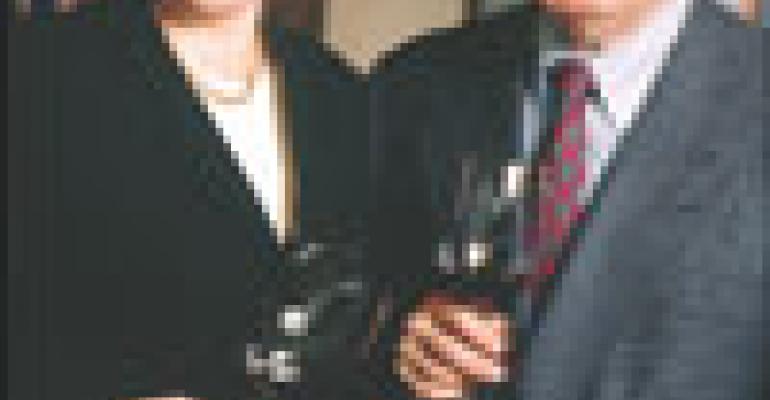Twenty years ago, when we went to restaurants and wanted something bubbly to begin dinner, we’d have to order a whole bottle of champagne. It was a bit much for just the two of us, especially if we wanted a red or white wine with our main course. In those days, most restaurants did not offer many wines by the glass, and very few restaurants had half-bottles of bubbly, either.
Nowadays, fortunately for us wine lovers, most restaurants offer a number of wines by the glass, including some bubblies. And according to the feedback we’ve received from restaurateurs, their wine-by-the-glass programs have definitely increased overall wine sales.
Restaurants can improve their sparkling wine sales by offering a diversified list of sparkling wines at different price points. Restaurants that list only costly Champagnes by the glass, for example, might be missing the boat on potential sales. We recently dined in a very good Italian restaurant in Manhattan that offered two Champagnes, and no other sparkling wines, by the glass. We found this rather surprising in view of all the very good Italian Proseccos available. We’d bet that if this restaurant offered one Prosecco for about $8 or $9 a glass along with the $16-a-glass Champagne, sparkling wine sales and profits would increase.
Just about every wine-producing country in the world makes its own sparkling wine; some countries, such as France and Italy, produce bubblies in many different regions. But the four most popular categories of sparkling wine that we see in the U.S. are French Champagne, of course; Cava—as Spain’s sparkling wine is called; Italian Prosecco; and California sparkling bruts.
What is great about these four categories is that they represent different price points: Cava is the least expensive, followed by Prosecco, with California bubbly next, and Champagne the most expensive. We suggest that every fine restaurant offer at least two different types of sparkling wine by the glass, to give customers a choice. Ideally, with rosés being so popular now, a couple of rosé bubblies would be a further logical enhancement.
Almost all Cava is produced in the Catalonian region of northeastern Spain, in the Penedés area, near Barcelona. Three local grape varieties—Parellada, Macabeo and Xarello—make most Cava, which is produced by the Champagne method, that is, with the second fermentation taking place in the bottle.
Cava has a pleasant, earthy, mushroom-like flavor, quite different from Champagne. The best news about Cava is its cost: most brands wholesale for $48 to $96 per case, with the priciest about $104 a case. Rosé Cavas do exist as well, but rosés are a bit uncommon in this category.
Prosecco sales have increased phenomenally in the United States during the past decade. Produced in the Veneto region of northeast Italy from the Prosecco grape variety. This light-bodied, dry, aromatic sparkler is a bit fruitier than Champagne. Its charming, delicate style makes it a perfect aperitif; Prosecco complements antipasti particularly well. Most Prosecco wholesales between $80 and $120 per case, although you can find some brands at lower prices. More and more rosé Proseccos are also now available.
California sparkling wines come in all price categories, but we’d rule out the least expensive, mass-produced bubblies for restaurants. The better California sparkling wines are made primarily from a blend of Pinot Noir and Chardonnay, and use the Champagne method for their second fermentation.
Generally made from riper grapes than Champagne is, California bruts tend to be fruitier than Champagne. They’re also frothier, and they generally don’t have the toastiness or flavor complexity of Champagne. Most California sparkling wines wholesale for $120 to $180 per case, but many prestigious California bruts are considerably more costly, rivaling Champagne. New York, Oregon, New Mexico and Virginia also produce good sparkling wines.
WINE OF THE WEEK Nicolas Feuillatte Brut NV (Blue Label) Champagne (France) This is one of Champagne’s great success stories. The brand is a relative newcomer in the fabled Champagne region, starting out in 1971. But today it is the fourth-largest selling Champagne in the U.S. The Blue Label nonvintage brut is fairly light-bodied, clean, fresh and lively. It’s ideal as an aperitif Champagne. Wholesale price per one case of 12, $256.
Champagne is a no-brainer, the one sparkling wine that most fine restaurants list by the glass. If your list is extensive, it’s not a bad idea to offer your customers three types of Champagnes by the glass, a Blanc de Blancs, a nonvintage Brut and a rosé. Champagnes begin at about $240 per case and go up from there. If you want to list a French sparkling wine at a lower price, you can select a bubbly from another part of France; good sparkling wines hail from the Loire Valley, Alsace, Limoux and other regions.
Restaurateurs generally list their sparkling wines in one of three different ways: by country or region; by featuring sparkling wines other than Champagne in one category, with Champagne listed by itself; or by listing all sparkling wines together. If you’re offering only a few wines, the third listing makes sense.
Whichever way you list your sparkling wines by the glass, having a diversity of types of bubbly and offering a wide range of prices makes real sense, especially as we head into the holidays.

